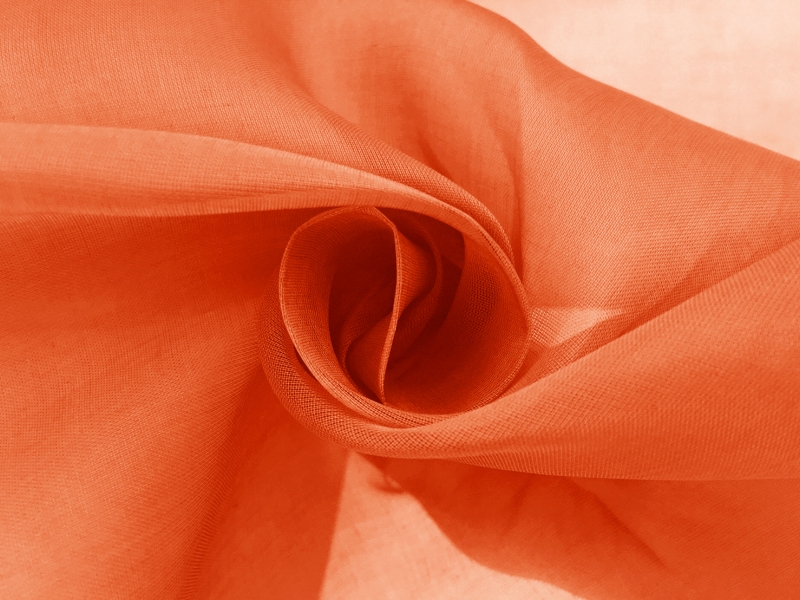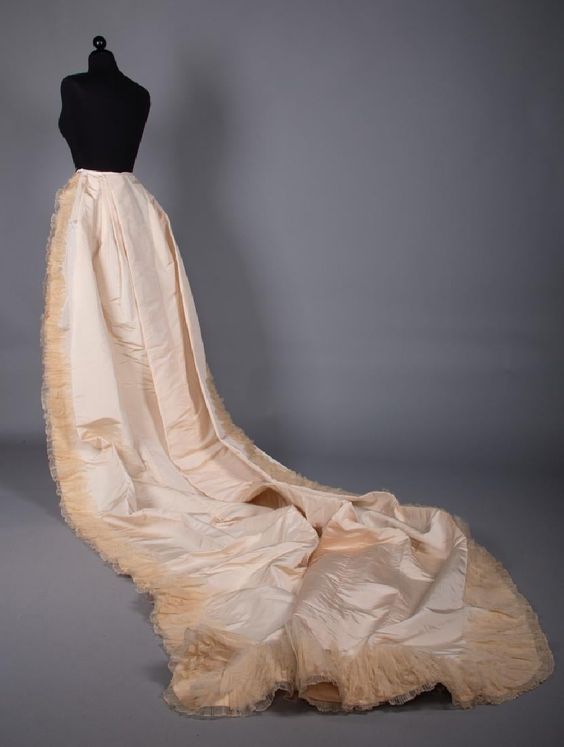| Fabric name | Organdy |
| Fabric also known as | Swiss organdy |
| Fabric composition | Plain-weave cotton fibers |
| Fabric possible thread count variations | 100-300 |
| Fabric breathability | High |
| Moisture-wicking abilities | Medium |
| Heat retention abilities | Low |
| Stretchability (give) | Low |
| Prone to pilling/bubbling | Low |
| Country where fabric was first produced | Switzerland |
| Biggest exporting/producing country today | China |
| Recommended washing temperatures | Hand wash, dry clean, or machine was cold |
| Commonly used in | Evening wear, dresses, baby clothing, children’s clothing, collars, cuffs, aprons, apparel lining, curtains |
 Swiss Cotton Organdy in Orange
Swiss Cotton Organdy in Orange
What is organdy fabric?
Organdy is the crispest type of cotton fabric. This textile is semi-transparent, and it is relatively delicate. Textile manufacturers can use a variety of different finishes to alter the crispness of organdy, but each type of organdy layers well, and this fabric is therefore commonly used to make ceremonial clothing or dresses for young girls. Organdy wrinkles easily, and it is similar to lawn cloth and batiste since it is a plain-weave cotton fabric.
History of organdy
During the Middle Ages in Europe, plain-woven garments became increasingly popular. At the time, linen was the primary plant-derived textile material used in Europe with sheep wool being its most popular animal-derived competitor. As a result, the earliest precursors to organdy, including lawn cloth and batiste fabric, were made with linen.
While lawn cloth and batiste originated in France, organdy originated in Switzerland, which historically and currently borders France to the east. Historical records regarding the origins of organdy are scant, but it’s reasonable to assume that early Swiss organdy producers invented this fabric as a lighter, crisper alternative to lawn cloth and batiste.
 Vintage 1950s Wedding Dress - 50s Cotton Embroidered Organdy
Vintage 1950s Wedding Dress - 50s Cotton Embroidered Organdy
Today, organdy is known as a cotton fabric, but just like batiste and lawn cloth, this textile was originally made using linen. It wasn’t until the 1600s that the Dutch and British cotton trade reached a volume capable of supplying Europe’s textile needs, and until this point, linen organdy was the norm, and this fabric may have been even crisper than its contemporary cotton counterpart.
While both lawn cloth and batiste eventually attained adequate popularity to become everyday materials for clothing in Europe, organdy was largely reserved for leisure activities or ceremonial occasions. It has been common for First Communion dresses to be made with organdy for centuries, and to this day, members of the Catholic faith and its offshoots continue to clothe their young girls in organdy for their first eucharists.
Throughout the 19th and early 20th century, organdy gained popularity as a garment for women’s dresses, and this trend reached its peak during the 1950s and 1960s. Puffy, light, and stiff, organdy dresses remain modest while subtly accentuating the alluring aspects of the female body.
Organdy fabric today
Today, organdy is not significantly popular. Largely overshadowed by cheap, synthetic alternatives like organza, genuine cotton organdy is largely relegated to women’s summer dresses. While organdy garments were traditionally bleached white, contemporary organdy dresses may be any color under the sun, and they often feature simple or complex patterns.
Single-layer organdy apparel is sometimes available, though it is usually designed to be worn on top of other garments since it is practically transparent. More commonly, apparel designers use multiple layers of organdy to produce puffy dresses that are mostly opaque. Organdy remains a delightful, attractive fabric even if it is only rarely used in modern fashion.
How is organdy fabric made?

The organdy production process follows a few universal steps:
1. Production of cotton yarn
Since organdy is only made with cotton, the first step in producing this fabric is the acquisition of cotton yarn. Cotton is derived from the bolls that surround the seeds of cotton plants, and these bolls are cleaned and carded prior to spinning. Once spun, cotton yarn is soft and off-white in color, and it is loaded onto reels for transportation.
2. Twisting and weaving of the yarn
One of the reasons that organdy is so thin and stiff is that textile manufacturers tightly twist cotton yarn before weaving it into organdy. The resulting tension produces more space between the warp and weft yarns in organdy fabric, and this twisting process also makes organdy yarn thinner. Once properly twisted, the cotton yarn is woven in a basic, plain-weave pattern.
 Vintage Women's Half Apron Organdy Pink with Flowered Hankie Pocket & Edging Handmade 1950s
Vintage Women's Half Apron Organdy Pink with Flowered Hankie Pocket & Edging Handmade 1950s
3. Acid finishing for stiffness
Organdy mainly derives its stiffness from a special acid wash process that is applied after this fabric is woven. The longer that organdy is exposed to this acid wash, the stiffer it becomes, and organdy manufacturers carefully calibrate this fabric’s exposure to acid to control its resulting stiffness.
4. Bleaching or dyeing
After it has been woven and washed with acid, organdy manufacturers may bleach this fabric to make it perfectly white or dye it in various colors. It’s also possible to embroider patterns on finished organdy fabric. Once complete, the organdy fabric is loaded onto bolts for transportation to apparel or homewares factories.
How is organdy fabric used?

Organdy remains a popular material for dressy or ceremonial clothing for girls. In addition to First Communion dresses, organdy is also commonly used to make flower girl dresses and other types of girl’s clothing used for important events. Organdy is also used to make dressy clothing for adult women including various forms of evening wear, and designers sometimes incorporate organdy into wedding dresses.
Traditionally, organdy was commonly used to make cuffs and collars for men’s clothing, but these formal accessories have largely gone out of style. It’s still relatively common to find men’s dress jackets and other formal apparel made with organdy. This material is ideal for curtains, and it is sometimes used to make decorative upholstery.
One of the most common applications of organdy is as a lining inside of clothing made with other fabrics. Due to its remarkable stiffness, organdy lends structure to types of fabric that would otherwise be too soft or shapeless. Used as a lining, organdy’s tendency to wrinkle is also concealed, which can make this thin, stiff fabric undesirable when used as the outer layer of a garment.
Where is organdy fabric produced?

Since organdy is a specialty fabric, reasonably large quantities of this textile remain produced in countries near its ancestral origins such as France, Switzerland, and Germany. However, China is the largest producer of finished textile garments, and India is the largest producer of cotton fiber. Between the two of them, these countries produce the vast majority of the cotton textiles on the market including organdy.
How much does organdy fabric cost?
Organdy can be one of the most expensive cotton fabrics due to its fineness and association with luxurious, high-end garments. However, this fabric is not as expensive as silk organza, and it is comparable in price to synthetic organdy. Organdy fabric increases in price relative to its decorations, embroidering, and other optional add-ons.
What different types of organdy fabric are there?

There are a few different kinds of organdy, and there are also a couple of fabrics commonly mistaken with organdy that are, nonetheless, distinct. Here are some examples:
1. Stiff organdy
This type of organdy has been subjected to the most intensive acid-washing process, and as a result, it is impressively stiff. Stiff organdy isn’t as popular for everyday apparel, and it’s usually reserved for ceremonial garments.
 Vintage Women's Half Apron White on White Nylon Organdy Embroidered with Clover & Flowers
Vintage Women's Half Apron White on White Nylon Organdy Embroidered with Clover & Flowers
2. Semi-stiff organdy
While semi-stiff organdy can be relatively hard to find, this type of fabric provides the best of both worlds with its reasonable stiffness combined with its moderate softness. This type of organdy is commonly used to make women’s dresses and evening wear.
3. Soft organdy
While still stiffer than most other types of fabric, soft organdy is softer and less stiff than any other type of organdy. This organdy variation is currently the most popular, and it is commonly used to make summer dresses and other casual or semi-formal women’s garments.
4. Cotton organdy
Cotton organdy is the only genuine type of organdy. While synthetic fabrics are sometimes labeled as “organdy,” this textile is only truly organdy when it is made with cotton. Organdy is not generally made with linen anymore, but if it were, this type of organdy would also be considered genuine.
5. Silk organza
Organza is the main alternative to organdy, and these types of fabrics are distinct due to the fibers used in their construction. While organdy can only be made with cotton, organza can be made with silk or a variety of synthetic fibers. In every other way aside from the fibers they contain, organdy and organza are highly similar.
 TAN SILK & ORGANDY BUSTLE GOWN, 1870s
TAN SILK & ORGANDY BUSTLE GOWN, 1870s
6. Synthetic organza
Due to the high cost of silk, an increasing number of textile manufacturers have decided to produce organza using polyester or similar fibers instead. While it’s possible to roughly approximate the desirable attributes of organza using synthetic fibers, polyester or rayon organza is not as soft or luxurious as genuine silk variants of this fabric.
7. Lawn cloth
Lawn cloth is considered to be in the same general textile category as organdy, and this type of fabric is often semi-transparent. Compared to organdy, however, lawn cloth has a much softer hand, and it is also considerably heavier than organdy fabric.
8. Batiste
Highly similar to lawn cloth, batiste is also semi-transparent while remaining soft and heavy like lawn cloth. Fabric historians suggest that the only salient difference between batiste and lawn cloth is this fabric’s origin story, which traces the invention of batiste fabric to a potentially mythical French weaver named Jean Baptiste.
How does organdy fabric impact the environment?
Organdy production only makes up a tiny sliver of the total annual output of the global textile industry, so the overall environmental impact of this fabric is relatively negligible. As a cotton fabric, organdy is also inherently reasonably sustainable since cotton fiber is highly biodegradable and cotton is a natural textile.
Cotton cultivation, however, often involves the use of toxic agrochemicals, and cotton is one of the world’s most notorious monocrops. As a harmful practice that degrades soil, monocropping is perhaps the most long-lasting harmful impact of cotton production.
In China and India, cotton workers are commonly exploited, leading to poverty and resulting in environmental harm. Textile manufacturers in these nations are also more likely to use toxic chemicals during cotton production, making organdy produced in Western nations more likely to be environmentally sustainable.
Organdy fabric certifications available
Organdy fabric produced in the United States or European Union may be eligible for USDA or European Commission organic certification. The OEKO TEX provides reliable, international organic certification. Additionally, organdy produced using pima cotton grown in the United States may be eligible for Supima certification.
